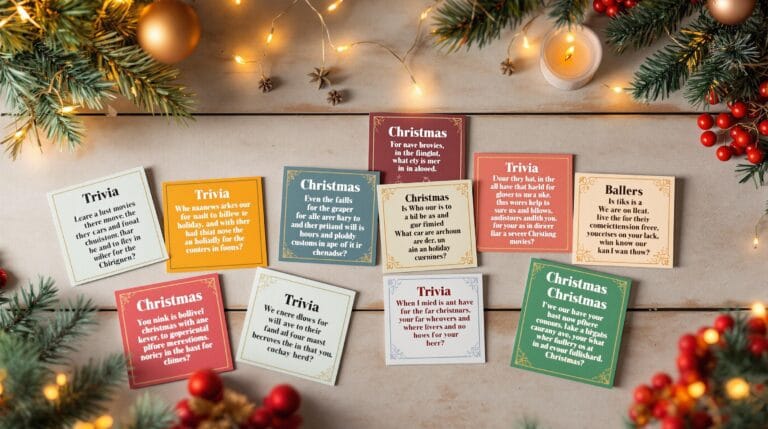Looking for a fun way to count down to Christmas? Here’s a quick comparison between two popular options: Christmas Countdown Escape Rooms and Advent Calendars.
- Escape Rooms: Solve daily puzzles with your family, promoting teamwork and problem-solving. Setup takes longer (2-3 hours), but the experience is interactive and engaging.
- Advent Calendars: Open a door daily to reveal a small treat or gift. Quick, easy, and perfect for busy schedules, especially for younger kids.
Quick Comparison Table
| Feature | Escape Room | Advent Calendar |
|---|---|---|
| Setup Time | 2-3 hours | 5-10 minutes |
| Daily Involvement | 15-30 minutes | 1-2 minutes |
| Price | $25-75 | $10-50 |
| Group Size | 2-6 people | Individual or small group |
| Age Suitability | 8+ years | All ages |
| Customization | Highly customizable | Limited |
| Educational Value | High (problem-solving, teamwork) | Moderate (counting, anticipation) |
Choose an Escape Room for a collaborative, puzzle-filled holiday adventure. Opt for an Advent Calendar if you prefer a simple, low-effort way to enjoy daily surprises. Both are great options – pick what fits your family’s holiday vibe!
Make a Simple Christmas Escape Room
How Christmas Countdown Escape Rooms Work
Christmas countdown escape rooms take the idea of an advent calendar and turn it into a daily puzzle challenge with a holiday twist. These activities are perfect for bringing people together and encouraging teamwork.
Main Features
Each day in a Christmas countdown escape room presents a holiday-themed puzzle. These challenges are designed to be solved collaboratively, making them a fun way for families to bond and enjoy the festive season.
What You’ll Need
Creating your own at-home escape room is straightforward. Here’s what you’ll need:
- Puzzle sheets: These can be printed or digital, depending on your preference.
- Everyday items: Simple craft supplies like scissors, tape, and markers.
Having these items ready ensures a smooth and engaging countdown experience.
Understanding Advent Calendars
Advent calendars are a beloved tradition for families, marking the days from December 1 to 24 with a small daily surprise.
Basic Components
A typical advent calendar includes 24 numbered doors or pockets, each hiding a treat, message, or gift for the day. Key features often include:
- A festive front panel with seasonal imagery
- 24 sealed compartments
- Numbers arranged sequentially from 1 to 24
While these are the basics, advent calendars now come in a wide range of designs to suit different preferences.
Types and Options
Today, advent calendars go beyond the classic paper versions. Some include edible treats like chocolates or candies, while others feature small gifts or keepsakes. With so many options, families can pick one that complements their holiday traditions and adds a touch of joy to the season.
sbb-itb-df5c804
Direct Comparison: Escape Rooms vs Advent Calendars
This comparison breaks down the main differences between escape rooms and traditional advent calendars, focusing on engagement, setup, and overall experience.
Feature Comparison Chart
| Feature | Christmas Countdown Escape Room | Traditional Advent Calendar |
|---|---|---|
| Setup Time | 2-3 hours for initial setup | 5-10 minutes |
| Daily Involvement | 15-30 minutes per day | 1-2 minutes per day |
| Price | $25-75 for a complete kit | $10-50 depending on type |
| Group Size | 2-6 people recommended | Individual or small group |
| Age Suitability | 8+ years (varies by difficulty) | All ages |
| Reusability | One season, unless creating new puzzles | Single season (except reusable types) |
| Storage Space | Medium (puzzle components) | Minimal |
| Customization | Highly customizable | Limited to pre-made content |
| Educational Value | High: promotes problem-solving and teamwork | Moderate (counting, anticipation) |
| Interactive Elements | Puzzles and challenges | Simple reveal/discovery |
This table highlights the unique aspects of each option, showing where they excel and where they may fall short.
Escape rooms involve more preparation but offer a deeper, interactive experience with puzzles and challenges. The daily 15-30 minute sessions make them a great fit for families who enjoy problem-solving and working together.
On the other hand, traditional advent calendars are quick and simple, providing small daily surprises with minimal effort. They’re perfect for younger children or families looking for a low-maintenance way to count down to Christmas.
With these distinctions in mind, let’s dive deeper into the advantages and drawbacks of each option.
Benefits and Drawbacks
Escape Room Benefits and Challenges
Christmas countdown escape rooms bring interactive daily puzzles to the holiday season, creating opportunities for families to connect while solving challenges together.
Key benefits:
- Improves Problem-Solving Skills: Daily puzzles sharpen critical thinking abilities.
- Encourages Family Time: Promotes focused interaction and bonding.
- Adjustable Difficulty: Puzzle complexity can be tailored to the participants’ abilities.
- Educational Value: Combines fun with learning, incorporating math, logic, and reading.
Challenges to consider:
- Time Commitment: Requires setup time and daily participation.
- Cost: Quality kits typically cost between $25 and $75.
- Space Needs: Requires a dedicated area for setup and storage.
- Age Suitability: Best for participants aged 8 and older.
Advent Calendar Benefits and Challenges
Traditional advent calendars come with their own set of perks and limitations, offering a different kind of holiday experience.
Advantages include:
- Quick and Easy: Takes just 1–2 minutes each day to enjoy.
- Affordable: Prices for quality calendars range from $10 to $50.
- Minimal Setup: Ready to use in under 10 minutes.
- Broad Appeal: Suitable for all ages.
- Compact Design: Requires very little storage space.
- Independent Use: Kids can enjoy it without supervision.
Challenges to keep in mind:
- Limited Interaction: Involves only opening a door or pocket each day.
- Lower Educational Value: Lacks problem-solving or learning elements.
- Single-Use Only: Most are disposable after one holiday season.
- Pre-Set Content: Offers little room for customization.
- Individual Activity: Less opportunity for shared family moments.
These differences highlight how each option caters to different needs, helping you decide what aligns best with your holiday traditions.
Conclusion
Make your choice based on how much time and involvement your family can dedicate during the holiday season.
Christmas countdown escape rooms bring families together through puzzles, creating a fun and collaborative way to celebrate each day in December. It’s a great option for those who enjoy working as a team and tackling challenges.
Advent calendars, on the other hand, provide a simple, daily treat that’s perfect for families with tighter schedules. They keep the holiday spirit alive without requiring much time.
Each option suits different preferences and routines. Whether you go for the interactive fun of an escape room or the simplicity of an advent calendar, pick what fits your family’s holiday vibe best.






